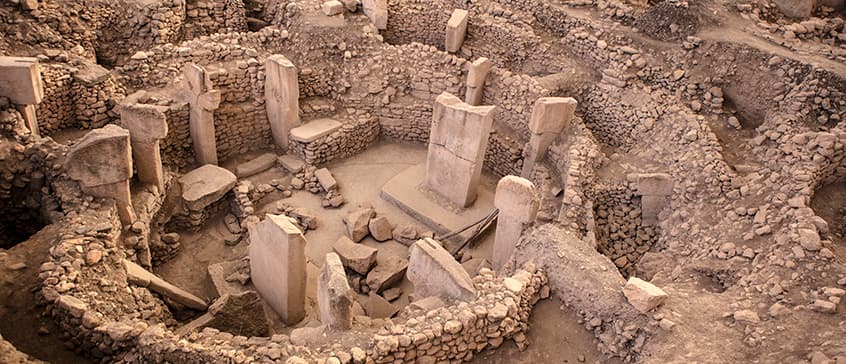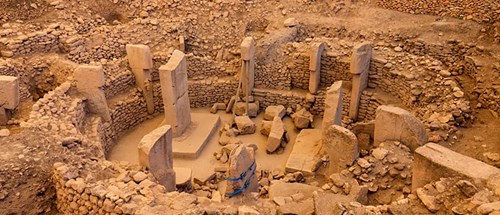Home / Humanities, Social Sciences and Law / Discover the starting point of civilization at Göbeklitepe
Discover the starting point of civilization at Göbeklitepe

By instructor Dr. Yonca Eldener
Meet the oldest temples constructed by humankind and travel back in time to uncover the myths, rituals, and monumental stone structures of the last hunter-gatherers—the first people to transition into farming societies.
The Stone Hills Project: Beyond a Single Site
Let’s dive into the world of giant pillars adorned with serpents, wild boars and vultures, as well as the oldest statues in the world, all intentionally buried 12,000 years ago. Join us for a remarkable journey to Göbeklitepe in this online course.
Since its discovery in southeast Turkey, Göbeklitepe has revolutionized our understanding of early civilization. This pushed back archeologists’ timeline of organized society by six thousand years, providing evidence of remarkable social complexity long before the advent of agriculture. Now, almost two decades after its discovery, ongoing excavations have revealed more than 10 similar sites in the region, known collectively as the "Stone Hills Project."
Decoding the Enigmatic T-Shaped Pillars
Until recent years, research and public attention focused primarily on the communal buildings of Göbeklitepe. The preliminary findings asserted that Göbeklitepe was solely a ritual site. Impressive T-shaped pillars adorned with rich imagery ignited the imagination of thousands questing for imminent answers to this mystery.
National Geographic magazine featured a cover story entitled, The Birthplace of Religion, at the time. However, as excavations expanded to more sites, new findings revealed domestic structures. Since its discovery, each finding fluxing from Stone Hills excavation sites poses a new question to be answered:
- who built these sites 12,000 years ago?
- why did they bury them?
- what do T-shaped pillars symbolize?
- did civilization originate from rituals, feasts or entrapment areas?
- does the imagery point to complex mythological content?
Cognitive and Social Leaps: The Neolithic Revolution
Today as humans, we live a lifestyle that transcends our biological limits because of the rapid pace of technological development. This gap did not emerge all of a sudden but has a footing in the emergence of settled life in the Neolithic Age. Among countless incremental developments over the 200,000 years of human history that gradually paved the way to today's civilization, two factors must have played a prominent role.
First would be the cognitive leap in the human brain that led to absolute thinking and social communication. The second must have been the conglomeration effect when, for the first time, crowds gathered around southeast Turkey to set the basis of almost all fundamentals that helped develop human civilization including architecture, social hierarchy, cooperation, specialization of labour, rituals, food production and communication.
Göbeklitepe’s Legacy: The Big Boom for Human Civilization
When our early ancestors decided to live together in large groups, they had to establish social, ritualistic, mythical and subsistence systems as means of cooperation. Somehow, these systems prevailed in conflicts and tribal fights, begetting a leap in the collective capacity of settlers. This sets the basis of the cultural revolution without which industrial and technological revolutions would not follow. In this regard, Göbeklitepe is a "big boom" for human civilization.

A unique opportunity awaits you to learn more about this archeological site. Together, let’s hear what giant pillars whisper to us after waking up from their long sleep. Register for this two-session online course today, and let’s delve into this hidden gem of ancient history.
About the instructor

Dr. Yonca Eldener has a PhD in urban planning. She has published academic papers in the USA and gave lectures on retailing, distribution and marketing. She worked as a retail and marketing executive in global corporations for 20 years. She is also the author of four published historical fiction novels. Her novel, The Guardian of Göbeklitepe, was a bestseller. She is an independent researcher and has given more than 50 seminars—including in Canada—on the Göbeklitepe neolithic site for 15 years.
- Posted February 3, 2025
Visit Registration
2nd Floor | Continuing Studies Building University of Victoria Campus 3800 Finnerty Road | Victoria BC | CanadaTel 250-472-4747 | Email uvcsreg@uvic.ca
2025 © Continuing Studies at UVic
Legal Notices |
Sitemap

